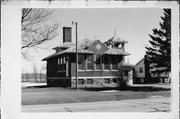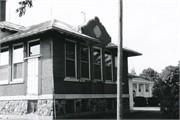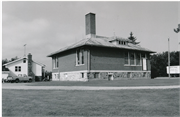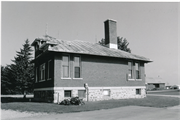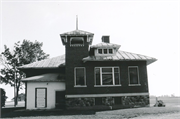Property Record
N1520 US HIGHWAY 41
Architecture and History Inventory
| Historic Name: | Feifarek School District #4 |
|---|---|
| Other Name: | Dura House |
| Contributing: | |
| Reference Number: | 118727 |
| Location (Address): | N1520 US HIGHWAY 41 |
|---|---|
| County: | Marinette |
| City: | |
| Township/Village: | Grover |
| Unincorporated Community: | |
| Town: | 29 |
| Range: | 22 |
| Direction: | E |
| Section: | 5 |
| Quarter Section: | NE |
| Quarter/Quarter Section: | SE |
| Year Built: | 1920 |
|---|---|
| Additions: | |
| Survey Date: | 1997 |
| Historic Use: | one to six room school |
| Architectural Style: | Spanish/Mediterranean Styles |
| Structural System: | Masonry |
| Wall Material: | Brick |
| Architect: | |
| Other Buildings On Site: | |
| Demolished?: | No |
| Demolished Date: |
| National/State Register Listing Name: | Not listed |
|---|---|
| National Register Listing Date: | |
| State Register Listing Date: |
| Additional Information: | A 'site file' exists for this property. It contains additional information such as correspondence, newspaper clippings, or historical information. It is a public record and may be viewed in person at the Wisconsin Historical Society, State Historic Preservation Office. 2000- "The Feifarek School, also known as the Town of Grover District No. 4 School, was constructed in 1920. The brick-veneered school shows the influence ofthe Spanish Colonial Revival style in its curvilinear parapet and the broad-eaved bell tower with brackets framing the bell openings, which gives each bell opening the appearance of a niche. The school sits on a fieldstone rubble foundation and is topped by a standing-seam, metal hip roof. The Feifarek School is emiched with exposed rafters and a stone watertable. Description The Feifarek School is located in a rural area. A single-family house stands immediately south of the school. A gravel drive runs east from USH 41, loops around the school, and returns to the highway. The Feifarek School is ell-shaped in plan with the long leg of the ell perpendicular to the highway and the short leg at the back of the building (see sketch plan). The school faces northwest. An enclosed, hipped-roof, concrete block entry porch is tucked into the ell. The entry porch displays exposed brackets, suggesting it was erected not long after the Feifarek School was completed. Above the entry porch, the hipped-roof bell tower rises at the west comer. It exhibits exposed rafters, brackets with curved knee braces, bell openings with niche-like appearance, and a stone panel. Raised letters on the panel read: "FEIF AREK SCHOOL DISTRICT NO. 4 1920." The bell has been removed. Northeast of the entry porch, a curvilinear parapet ornamented with a cross-shaped medallion appears on the main block. The first story exhibits five, one-over-one, double-hung sash windows. Three small windows are found at basement level. A ribbon of three, one-over-one windows are set at the north comer on the northeast-facing facade. A fourth window in the group has been converted into a doorway. Four irregularly-distributed windows appear in the basement. A hipped roof dormer with three square windows sits on the roof. The rear facade faces southeast and features two sets of paired one-over-one windows placed at either end of the facade. The basement displays four irregularly-distributed windows. A simple brick chimney with a stone cap pierces the roof. The bell tower dominates on the southwest-facing facade. East of the bell tower, a hipped roof dormer with three square windows appears on the roof of the main block. This facade is symmetrical with a large window centered between two, one-over-one windows. Two smaller windows are found at basement level. At the west end on this facade, the enclosed entry can be seen. A modem door gives access to the entry. The interior of the Feifarek School is largely intact. The original entry doors survive within the enclosed entrance porch. The entrance leads into a large foyer with a coat closet and restroom at the rear. A pair of doors give access to the single classroom. The original blackboards and chalkboards remain. A small stage is found at the rear of the room. The interior finishes have been retained and include wood flooring, simple Craftsman sunounds, and wainscoting. Modern flourescent lighting has been installed. Alterations The Feifarek School retains most of its original features. The only visible changes to the exterior are the enclosed entry and the addition of a door on the notiheast facade. The decorative Spanish Colonial Revival features have been preserved and include the corner bell tower with niche-like bell openings, curvilinear parapet, exposed rafters, and brackets with curved knee braces." -"Feifarek School; Town of Grover District No. 4 School", Prepared by Mead & Hunt, Inc. (Stacey C. Pilgrim), (2000). 1997- "The Feifarek School District No. 4 building was constructed in 1920 in the Spanish Revival style. The two-story brick building has a stone foundation and hip roof with two dormers. The roof is covered by a standing seam metal roof and a brick chimney with a limestone cap is found to the rear of the roof. A corner bell tower has a hipped metal roof with decorative brackets in the eaves. A limestone nameplate is also found on the tower reading, "Feifarek School District No. 4." The main facade faces USH 41 and is dominated by a Spanish style parapet with a limestone modillion. The facade is divided into five bays, each bay having one double-hung sash window with one-over-one construction. Each of the windows has a limestone sill. A limestone watercourse is located above the foundation. A concrete block addition is attached to the bell tower. This addition, covered by a hip roof and containing glass block windows, serves as an enclosed entry into the building. The building retains good integrity. Marinette County was formed in 1879 from a part of Oconto County, but it was not until 1892, that Grover Township separated from Peshtigo Township. As population in the area began to increase, schools were established to provide education to the growing number of children. The first schools established in Marinette County were small schools in the city of Marinette. It was not until after 1870 that the rural, county-wide schools began to develop. Prior to 1963, when schools were largely consolidated, there had been 112 rural one-room schools, 19 state-graded schools, and eight high schools outside the city of Marinette, including the Feifarek School." -"Harmony, Marinette West, Oconto East and West, and Pensaukee, 7.5", WisDOT#1154-01-00, Prepared by Mead & Hunt, Inc, (1997). |
|---|---|
| Bibliographic References: |
| Wisconsin Architecture and History Inventory, State Historic Preservation Office, Wisconsin Historical Society, Madison, Wisconsin |

